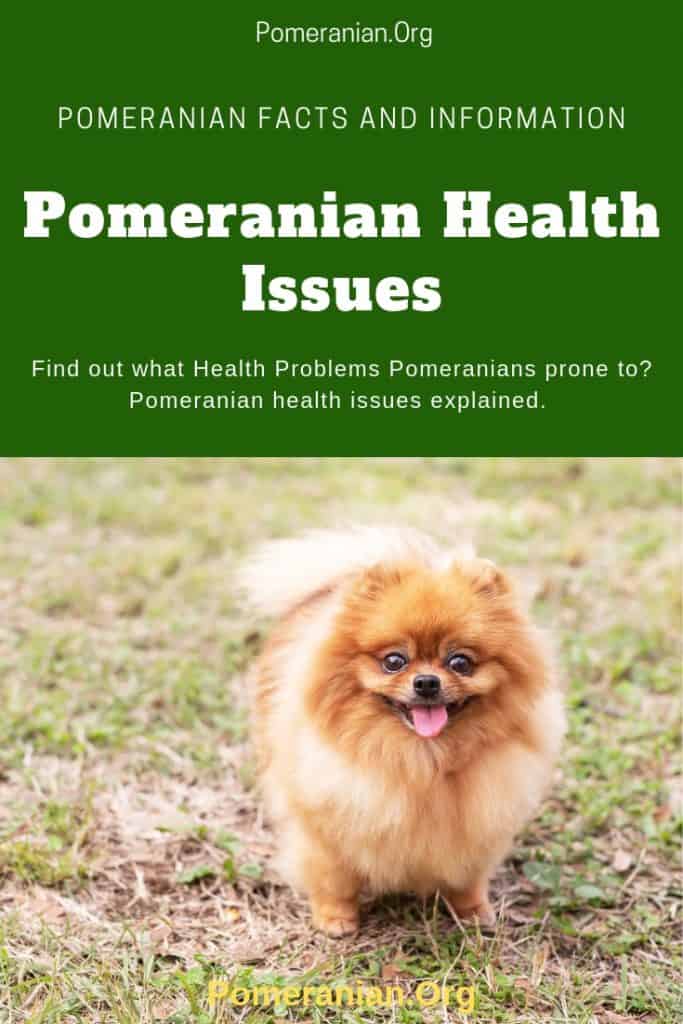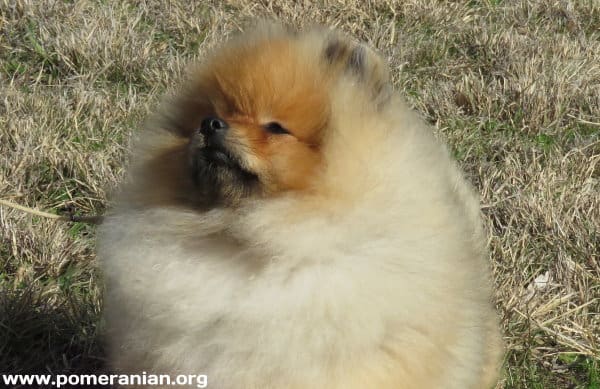Last Updated on 24/04/2024 by Denise Leo. Post first published on November 28, 2022.
This complete article about Pomeranian health issues has been fact-checked by Dr. Muqeet Mushtaq. DVM, University of Animal and Veterinary Sciences, 2019
MSc. (Hons.) (Animal Breeding & Genetics), University of Agriculture Faisalabad, 2021
Pomeranians are small, toy-sized dogs that come in a variety of colors. They’re famous for their fluffy coats and fun personalities. But sadly, they can also be prone to health issues that owners may not know about or understand until it is too late.
This article will cover the most common Pomeranian health problems and how you can help prevent them by providing your pup with proper care.
I explain the common Pomeranian health issues this breed is prone to. This dog breed is a sturdy little dog with few health problems.
Now you ask, “What health problems do Pomeranians have? Do Pomeranians have health problems?”
All living things can suffer health issues common to their species, and the Pomeranian is no exception. Owners should know about common Pomeranian health issues, how to spot them, and how to care for them.
The excellent news is that there are many things you can do to help your Pomeranian. So start by educating yourself on these topics to prepare for any health problems with your dog.
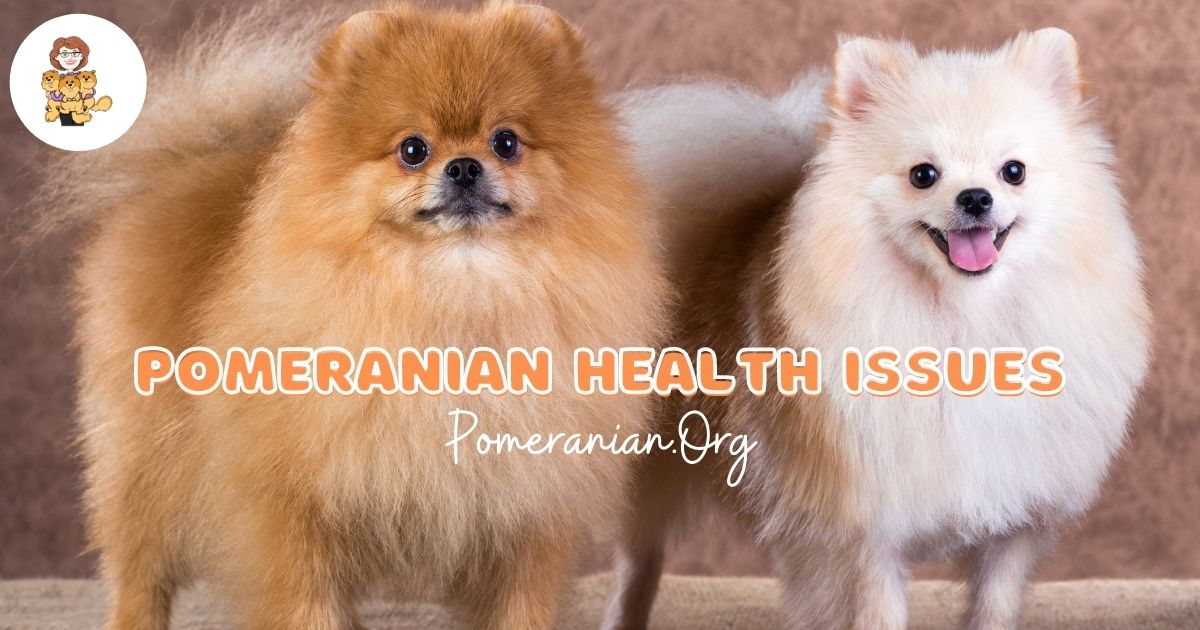
Common Pomeranian Health Issues Are:
- Tracheal Collapse
- Patella Luxation
- Severe hair loss syndrome
- Pomeranian Reverse Sneezing
- Hypothyroidism
- Cushing’s Disease
- Heart Disease
- Eye Problems
- Seizures
- Puppy Hypoglycemia
- Liver Shunts
- Open Fontanel In Puppies
- Teeth Problems
- Gonad Descent Abnormalities
This does not necessarily mean your Pom will acquire health and fitness concerns. However, the above are common health problems in Pomeranians.
This article will give you a better understanding of the Pomeranian dog health problems mentioned above.

Pomeranian Patella Luxation
The most common Pomeranian health problem in many “toy” dog breeds is patella luxation or slipping kneecaps. Environment, as well as genetic influences, play a big part in the health of your Pomeranian. Correct diet and medication may improve this health issue. Pomeranian puppy knee problems sometimes resolve themselves with the proper diet and exercise.
Surgery may be your only option if the Pomeranian leg problems are severe. Surgery is strongly recommended for third and fourth grades.
Surgery is required in grade 2 only when clinical signs are significant, and surgery is never advised for grade 1 luxating patella issues.
Because bone deformities and loss of cartilage can develop in untreated cases, the best person to talk to is your Veterinarian.
Feeding your puppy a balanced diet may help prevent many health problems, including Pomeranian joint issues later in life. Take care of your Pomeranian by keeping them trim and fit, and never allow a young puppy to jump down from steps, beds, or furniture. Pomeranians with a patella grading over two should be removed from any breeding program.
Pomeranian Breathing Problems
Pomeranian breathing problems include the following:
Pomeranian Collapsed Trachea
Pomeranians who make honking or cough-like sounds (much like a cat regurgitating a hairball) may have collapsed tracheas. An X-ray can diagnose the issue.
Other symptoms of tracheal collapse include a wheezing sound while breathing.
Collapsed Trachea in Pomeranian Treatment
Medication can reduce the symptoms. Severe cases may require surgical treatment. Surgical procedure: the sternohyoideus muscles divide.
Pomeranian trachea problems can be deadly, and immediate veterinarian treatment is required.
Pomeranian Wheezing Gagging?
Pomeranian coughing? Any Pomeranian breathing issues, such as coughing, should be investigated. And it could also indicate worms, heart disease, or hairballs. Pomeranian puppies have been known to die from hairballs. Fur can be ingested by the puppy while sucking the mother.
Pomeranian Reverse Sneezing (Pharyngeal Gag Reflex)
Reverse sneezing in Pomeranians happens when a dog has a rapid, sudden, forceful inhalation of air via his nose. This causes him to make numerous repeated snorts that can sound similar to choking. It’s like he’s attempting to inhale a sneeze, hence the nickname “Pomeranian reverse sneeze”).
Your Pomeranian dog may do this because he has an irritating larynx or palate area, which can cause muscular spasms in the pharynx. When your Pom does a Pomeranian reverse sneeze, he can make snorting, hacking, or honking noises as he inwardly gasps. It generally occurs if your dog gets too excited.
However, reverse sneezing in Pomeranians may also happen after he has eaten food, lapped up water while he’s running, or if he’s pulling hard on the leash.
Always use a harness when walking your Pomeranian instead of a collar. An average Pomeranian reverse sneezing episode lasts a few seconds, but some dogs have it for a few minutes and several times daily. You can usually stop the spasm if you softly massage his throat or gently shut his nostrils until he finally swallows.
Causes of Pomeranian Reverse Sneeze Include:
Tooth root infections, nasal irritation, allergic reactions, and air irritants like perfume, smoke, and pollen.
You must talk to your vet if your Pom dog has this problem. If the attacks happen frequently, your vet will prescribe antihistamines to give your dog the chance to end the sneezing. If it happens straight after he gets the nose vaccination for kennel cough, it is wise to give him antibiotics.
Most Pomeranians only have an occasional episode of reverse sneezing and still lead a healthy life because it’s not harmful, and treatment isn’t always required. However, don’t confuse Pomeranian reverse sneezing with more severe problems such as collapsed trachea or heart disease. When you see anything you don’t understand, always consult your vet, as it’s better to be safe than sorry.
Severe Hair Loss Syndrome
Severe Hair Loss Syndrome is often called Black skin disease, BSD, or Alopecia X. An accurate diagnosis is usually a very long, inconclusive, and expensive exercise.
Many Pomeranian skin conditions can cause the problem, such as hypothyroidism or low thyroid, Cushing’s disease, genetics, kidney and liver diseases, eczema, mites, fungus infections, and allergies.
Talk to your Pomeranian’s breeder for guidance on this problem, and ask your veterinarian for help diagnosing the cause and suggesting suitable treatment for Pomeranian black skin disease. For more information on coat loss in Pomeranians, click here.
Hypothyroidism in Pomeranians
What Is Hypothyroidism? Hyperthyroidism occurs when the thyroid gland is underactive; in other words, it’s not producing enough thyroxin (the thyroid hormone).
Thyroxin is a vital hormone that assists in almost all metabolic processes in a dog’s body. Unfortunately, hypothyroidism is a widespread disease among dogs, including the Pomeranian.
Prospective Pom puppy owners may request thyroid test results for the parents of the puppy they are contemplating purchasing. Pomeranians’ test results often return as within the average range but low with the average.
Pomeranian Hypothyroidism Symptoms:
- Constipation.
- Dry skin.
- Weight gain.
- Infertility.
- Feeling colder than normal.
- Depression.
- Low energy.
- Dry thinning hair and loss of hair.
- Thickening of the skin Hyper-pigmentation (darkening) of skin color.
- Skin bacterial infections.
- High cholesterol
- Anemia
- Ear infections
Potential Causes of Hypothyroidism:
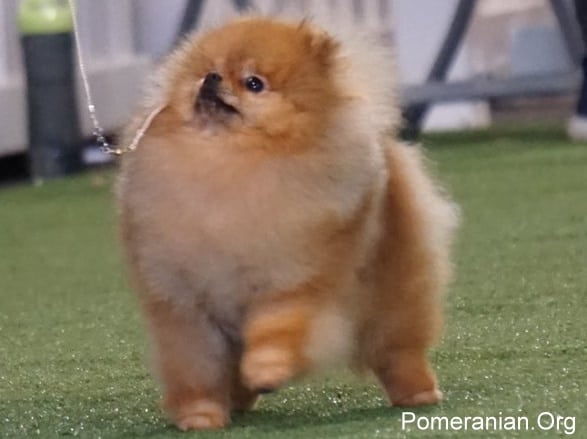
- Severe stress or trauma to your dog’s system (especially when he’s a puppy).
- There is insufficient iodine in his diet. A vitamin E and kelp supplement can usually fix this issue. Vitamin E aids in the body’s proper use of iodine.
- Autoimmune thyroiditis. His autoimmune system may attack his thyroid without apparent reason. Place your dog on a hypoallergenic diet comprised of rice-based food, premium lamb, and Ultra Omega-Linic (containing vitamin E, salmon and blackcurrant oils, and spirulina). This mix will generally help to relieve the problem.
Your vet might also tell you to give your dog thyroid medication. - Nutritional deficiencies (particularly zinc). Feed your pet premium quality food and a suitable multi-vitamin & mineral supplement as often as your vet recommends.
- Insufficient light. Don’t allow your dog to spend too much time in the dark, and don’t turn off your lights too early when evening approaches. Each day, you should take your dog for a walk for exercise so he gets exposed to natural sunlight.
- Idiopathic atrophy. Your dog’s thyroid degenerates for no apparent reason.
- Some medications used in the treatment of hyperthyroidism may cause the problem to occur.
Hypothyroidism in Pomeranians Diagnosis and Treatment:
Your vet will need to do blood tests and a complete examination before diagnosing hyperthyroidism because numerous other canine diseases can cause some of the relevant symptoms. If the diagnosis IS hyperthyroidism, your vet will probably prescribe thyroxin.
The thyroid gland can be stimulated by ginger root and zinc. Daylight exposure, exercise, and a suitable diet will also help him.
Hypothyroidism can’t be cured, but there is a treatment for low thyroid function.
FDA-approved drugs are:
- THYRO-TABS CANINE(Levothyroxine sodium tablets).
- TyroKare(Levothyroxine sodium tablets).
Follow the advice of your vet and you can try this treatment before you use thyroxin:
- Rice-based food and premium lamb.
- Half a multivitamin/mineral Pet-Tabs Plus supplement every day.
- 1 x 200 mg capsule of 4:1 ratio ginger concentrate extract each morning and evening. To help your dog consume it, you can wrap it in a small amount of meat or tinned food. You may also open the capsule and sprinkle the contents over his food. Then the taste is masked.
- 1 “green” supplement. This might be a Phyto-Derm or spirulina capsule or spirulina powder. As above, you can mask the taste, so your dog gets what he needs with no fuss. Make sure he’s big enough to swallow such things.
- One Ultra Omega-Linic soft gel (containing black currant and salmon oils) (Salmon, Black Currant Oil) each morning and evening. The majority of dogs will consume the gel on their own. If not, prick it and squeeze its contents onto your dog’s food.
- At least 30 minutes of exercise every day.
- Exposure to light for 12 hours each day. Make it natural light as much as you can.
After years of testing the thyroid levels of many Pomeranians, I have found that low within the normal seems correct for most Pomeranians.
The Orthopedic Foundation for Animals (OFA) has a registry on canine health tests. For further details, go to the OFA website and check out the testing available for Pomeranian thyroid issues.
Cushing’s Disease Pomeranian Facts
Hyperadrenocorticism (better known as Cushing’s Disease) is an unpleasant, not unheard-of disease your Pomeranian may suffer from if he experiences disproportionately high levels of anxiety and stress. This disease causes prolonged, high levels of a hormone called cortisol, which can mean your Pomeranian has a tumor.
There are several symptoms that your Pom may exhibit, and it might indicate he has Cushing’s Disease. These symptoms include:
- Extreme thirst (that triggers more frequent urination and involuntary urination).
- Panting excessively.
- A marked increase in appetite.
- A big “potbelly.”
- Lethargic.
- Loss of hair.
- Skin that thins out.
- Fragile skin that easily bruises.
- Skin infections.
- Infertility.
- Reduction in muscle mass.
- Obesity.
- Excessive fat around his shoulders and neck.
It’s important to note that if your Pomeranian does experience one or more of the symptoms listed here, it doesn’t automatically mean he has Cushing’s Disease. These and many other symptoms are common to many canine maladies.
However, if you notice symptoms that aren’t what you would call “normal” for your Pomeranian, either ring your vet or, if necessary, take him so the vet can check him out thoroughly. You might discover your dog does have Cushing’s Disease or a different problem. On the other hand, your Pom may be given a clean bill of health.
Generally speaking, Pomeranians don’t get this disease until they are adults. Puppies can contract this disease, but it’s rare for symptoms to appear until adulthood. If your dog only displays one or two signs, it’s hardly likely that he has Cushing’s Disease. However, ring the vet as a matter of urgency if you can put ticks to quite a few on the list above.
Your vet can do a quick, easy blood test to see if your Pomeranian has Cushing’s or not. The helpful news is that the same test can give him more information regarding your Pom’s overall health.
The usual test for Cushing’s is the LDDST (the long-form name is the low-dose dexamethasone suppression test). The test reveals whether your dog’s cortisol levels are too high or are in the normal range.
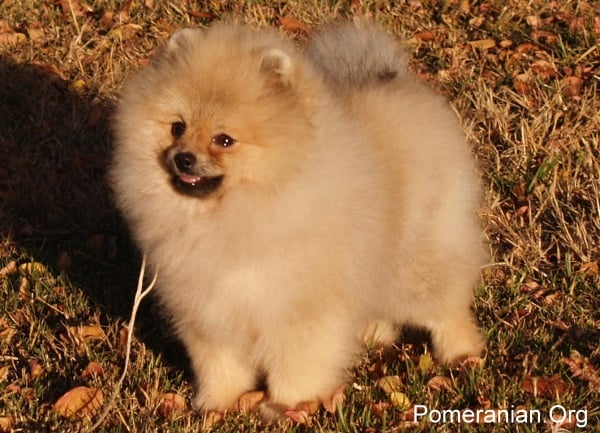
It’s essential to understand why this disease occurs and if you can do anything about it. The cortisol (stress) hormone is critical to dogs, cats, and people.
It’s triggered in stressful scenarios, including the “fight-or-flight” decision where people and animals are trapped and must choose whether to escape or fight (assuming they have a choice).
Cortisol gets secreted in the endocrine system from two glands, namely the pituitary and adrenal glands. When cortisol is at its best level, it assists your dog in dealing with stress and helps balance the immune system.
If your Pomeranian’s cortisol levels are too high, his immune system becomes weak, thus making him more susceptible to infections and diseases.
Around 85% of dogs diagnosed with Cushing’s have a pea-sized tumor inside the pituitary gland, at the bottom of your Pomeranian’s brain. It’s known as the Pituitary Gland as it creates numerous hormones, each traveling on its way through the body.
Fortunately, it’s pretty rare for tumors that produce Cushing’s disease in Pomeranians and dogs to be malignant, so that’s good news! The other 15% of dogs with Cushing’s have a growing tumor above their kidneys.
There’s a lot to learn about Cushing’s Disease in Pomeranians, and this website is an excellent place to start, primarily as it affects dogs and two-legged creatures known as human beings.
Pomeranian Heart Disease
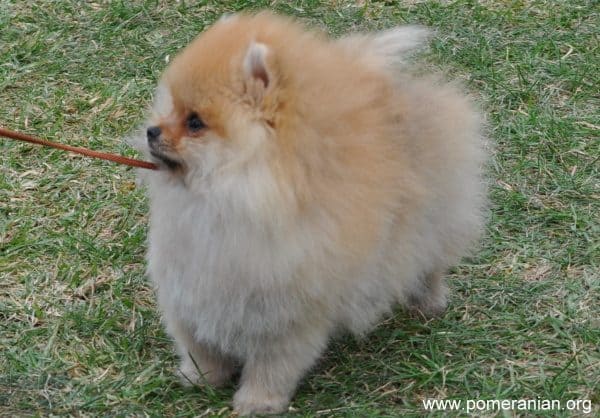
Do Pomeranians have heart problems? Yes, Pomeranians can experience heart issues. Pomeranian heart problems ranging from highly minor to life-threatening are common in all dogs.
Like humans, Pomeranian heart failure is associated with genetic factors and poor lifestyle: including poor diet, obesity, and lack of exercise. A Pom puppy may have a Pomeranian heart murmur.
Again, any reputable Pomeranian breeder should have a plethora of information on a puppy’s lineage to help determine if heart issues run in the family. Click here for more details on Pomeranian Heart Disease.
Pomeranian Eye Problems

Do Pomeranians Get Cataracts?
While everyone knows cataracts are a problem that’s quite common among humans, many don’t realize that dogs (and cats) can also face this problem.
Cataracts are one of the most common health problems in dogs, and Pomeranians, as toy dogs, are even more prone than larger dogs.
Your Pomeranian can suffer from a cataract when he’s any age, from birth right into the senior stage of his life.
There are numerous symptoms including:
- Swelling on and/or around the eye.
- The eye changes color, with a grey, blue or white tint.
- Redness around or in the eye.
- Rubbing his eyes, and can cause pain for him.
- Your Pomeranian bumps into walls, furniture, and anything else in his path, all because his vision is blurry.
If you think your Pomeranian eye problems are cataracts in one or both eyes, take him to the vet to confirm this diagnosis through ultrasounds, blood tests, and possibly an electroretinogram.
If your Pomeranian has cataracts, they can often be removed through surgery. Never ignore any health problems your Pomeranian may have because you may cause him to go blind if he hasn’t been tested, properly diagnosed, and treated accordingly. Studies reveal that 75% of dogs with cataracts will go blind after a year of being diagnosed.
Cataracts are more prevalent and clinically severe in dogs than in cats. Most cataract issues in Pomeranians are inherited. However, it’s certainly not the only cause. Diabetes is both a common cause and very preventable.
Among the many older Pomeranian health issues are cataracts. Other causes include eye trauma, systemic drug toxicity, and other eye conditions.
Nuclear sclerosis is a less severe problem your Pomeranian may experience and it’s often misdiagnosed as cataracts. If your Pom’s cataracts are bad, surgery would be the number one recommended treatment. However, if it’s misdiagnosed as nuclear sclerosis, that often means surgery is not required.
As an owner, you need to care for your dog all the time and ensure the vet sees him regularly to catch problems before they become too severe. Diabetes is a major cause of cataracts, but if you keep your dog at an ideal weight, feed him healthy food and give him whatever supplements are needed, he should stay healthy.
Entropian or Inward Rolling of the Eyelid
This causes the eyelashes to rub on the surface of the eye. Pomeranians with entropion show discomfort by squinting and may be sensitive to sunlight. Surgery can quickly correct entropion.
Surgery is best left until the Pomeranian is over 12 months of age. With growth, the problem may correct itself. If left untreated corneal ulceration and scarring may develop.
Pomeranian Hip Problems
Legg Perthes Disease in Dogs

Legg-Calve-Perthes Disease (LCP Disease) involves degeneration of the head of the femur bone. Legg-Calve-Perthes Disease (LCP Disease) usually only occurs in small dog breeds.
Although the cause of Legg-Calve-Perthes Disease (LCP Disease) isn’t known, recent research has come up with significant proof to suggest it is connected to blood supply problems to the femoral head. The reduced blood supply could result from injury, abnormal sex hormone activity, or genetics.
Perthes Disease generally occurs in small dogs between 4 to 12 months of age. Loss of blood supply to the joint interferes with normal bone and joint development, resulting in lameness and wasting of the affected leg.
Legg-Calve-Perthes Disease affects both male and female dogs, but male dogs are four times more likely to develop the disease than female dogs.
Signs of Perthes Disease
- In the early stages, your dog will experience pain when he extends his hip joint while exercising or being examined by the vet.
- He’ll also have a severe limp and, as the disease progresses, will refuse to use or put any weight on the affected leg.
- Once the disease has advanced, he will suffer a visible shortening of the affected leg.
- Muscular atrophy in the affected leg.
- Chewing or licking of skin over the hip area.
- Anxiety.
- Aggressive due to pain.
Treatment: Surgery is the preferred method of treatment for Legg-Calve-Perthes Disease. Post-surgery physio will help, and exercises such as swimming are encouraged to rebuild leg muscles.
Pomeranian Seizures or Idiopathic Epilepsy

There are four major categories of seizures in Pomeranian dogs:
- Generalized seizure category (both sides of the brain are affected by urination, unconsciousness, and defecation).
- Focal seizure category one side of the brain affected
- Focal to generalize seizures category(most common in which focal seizures develop into generalized, particularly in the absence of care and treatment.
- Unknown seizures.
Causes, Symptoms, and Treatments For Pomeranian Seizures
While most people know that humans can suffer from seizures, it’s less commonly known that canines experience them. A Pomeranian seizure may occur once or multiple times. If it’s ongoing, it’s called epilepsy.
Do’s and Don’ts if Your Pomeranian Has a Seizure
To Do:
- Remain calm while you talk to your Pom. He’ll sense your demeanor, and it may help him recover faster.
- Move all furniture and other objects away from him so he doesn’t hurt himself while he’s convulsing.
- Place a thin pillow under your Pom’s head for protection.
- Turn off bright lights and anything noisy (TV, radio, or loud music).
- Remember everything that happened before and during the seizure, as it could be critical information for the vet.
- Ask somebody in the house to ring and warn the vet or hospital that you’ll bring your dog for emergency treatment. This speeds up the treatment process because they’ll expect you wherever you need to go.
- Only move him once the seizure has stopped.
Not To Do:
- There’s no need to hold your dog’s tongue.
- Don’t let other animals or children near your dog.
- Please don’t move your dog while he’s having a seizure, except for gently placing his head on a thin pillow.
Pomeranian Seizure Symptoms Categories
There are a few seizure categories and numerous types of seizures within each.
Symptoms and treatment methods may be the same, similar, or dissimilar. However, knowing how they differ could potentially save your Pomeranian’s life.
The Generalized Seizure Category
The Tonic-clonic (aka grand mal) seizure has two phases. These seizures are the most common, and symptoms often occur beforehand, including weakness, irritability, anxiety, mood swings, weakness, and dizziness.
These seizures are usually caused if your Pomeranian has drug toxicity or low salt or sugars. A grand mal seizure lasts an average of one minute.
Tonic seizure: Your Pom will have non-vibratory contractions of his muscles, clearly visible in his limbs as they tighten and relax.
This happens abruptly and can last from 10 – 60 seconds. It mostly happens if your dog is in non-REM sleep or feels drowsy.
Atonic seizure: This often happens simultaneously with a tonic seizure. Its nickname is the “drop attack” because your Pomeranian’s body goes limp, and he loses consciousness for 1-2 seconds before recovering quickly.
Clonic seizure: In the clonic phase, your Pom’s seizure symptoms will be particular and can include excessive drooling, strange jaw movements, enlarged pupils, moving in one spot, suddenly losing consciousness, and muscles spasming as they relax and contract. It lasts up to a minute.
Myoclonic seizure: Your Pom’s muscles contract quickly and his facial and pelvic muscles can twitch or jerk. Younger dogs with a diagnosis of symptomatic or idiopathic epilepsy are the most common victims of this particular seizure.
Absence seizure: Your Pomeranian loses consciousness and won’t remember convulsions and repetitive movements once he wakes up within 10 seconds.
Focal Seizure Category
Focal seizures happen in a tiny area of one hemisphere of your Pomeranian’s brain. It’s common to have more than one episode, often originating in the same brain region. There are two types.
Focal seizures with retained awareness: There are numerous potential symptoms, but your dog doesn’t lose awareness.
Focal seizures with a loss of awareness: There are lots of symptoms, and your dog can lose his awareness and consciousness, making this the more serious form.
The Rarest Category is the Status Epilepticus
This powerful seizure lasts more than 30 minutes and is caused by consuming large amounts of chocolate or harmful toxins. This is usually fatal but preventable by childproofing your home. To do this thoroughly, crawl around on your hands and knees so you can see everything from your Pomeranian’s point of view. Do it regularly and remove anything dangerous.
Pomeranian Seizures Treatment
Talk to your vet, who can advise on the best type of treatment. Medication may help Pomeranian seizures.
Treatment of seizures:
Antiepileptic drugs(AED) focus on decreasing the severity and frequency of seizures.
This approach is successful only in 15-30 % of dogs.
Pomeranian Puppy Hypoglycemia( Very Low Blood Sugar)

Hypoglycemia in young, tiny, and active Pomeranian puppies is not unusual. Discuss any potential problems with hypoglycemia and your new Pomeranian baby with the Breeder before collecting the Pomeranian Puppy. Hypoglycemia is very low blood sugar. Glucose is the form of sugar found within the bloodstream. Glucose is created during the digestion of foods, and it can be stored within the liver in a storage form called glycogen.
The majority of cases of low blood sugar (hypoglycemia) in puppies result from insufficient or low-quality food. Excessive exercise or even overhandling a new puppy may cause the puppy’s body to require more sugar than is accessible.
A young puppy with hypoglycemia will undoubtedly be lacking energy. Glucose (sugar) is the fuel the body burns for energy. Devoid of glucose sugars, the puppy will be lethargic. In severe cases, the puppy might even seize and can become comatose and die in very serious cases. Glucose is essential for the brain tissue and muscles to function.
The dangers of Hypoglycemia depend on the severity or degree. Hypoglycemia is easily remedied due to insufficient food, excessive exercise, or too much handling.
Suppose, however, the cause is a liver disease preventing the storage of glucose as glycogen or intestinal disease interfering with the absorption of food. In that case, hypoglycemia might be chronic and even life-threatening.
If your puppy is lethargic and fatigued as a result of low blood sugars, immediately supply glucose. Karo Syrup and honey are excellent sugar options and should be immediately given to your puppy. Please contact your veterinarian without delay. Nutrical High-Calorie Supplement is an excellent supplement for very small and young Pomeranian puppies.
Liver Shunts
As most of you know, the liver can be described as a wonderful organ. It has numerous vital functions, such as: Acting as a massive filter to eliminate blood-borne toxins synthesizing and distributing proteins for the body’s use and storing sugar as glycogen.
This amazing organ needs a constant blood flow so it can do these jobs effectively. If there’s a liver shunt present, it means your pet’s blood flow has been compromised.
There are two main liver shunts and they are:
• Extra-hepatic (outside your pet’s liver).
• Intra-hepatic (inside his liver). Although such shunts are generally problems faced by dogs, cats may also have them sometimes.
How Does a Liver Shunt Form?
The technical term for a liver shunt is ductus venosus. It’s a natural growth while the puppy forms inside his mother’s uterus. However, the puppy’s liver doesn’t work during the gestation period.
The mother’s liver handles the detoxifying process for herself and her litter before birth. As the gestation period comes closer to its end, the ductus venosus is designed to shut, thus ensuring the puppy’s liver will be functional once he’s born. The puppy will have an open shunt if it doesn’t close before birth.
This one is known as the patent ductus venosus and this is an anti-hepatic shunt. If the puppy has an extra-hepatic shunt, he has a genetic anomaly. The blood flow to the liver gets rerouted via an abnormal blood vessel that exists outside the liver. This shunt may develop in utero. Although the ductus venosus shuts properly before birth, the external shunt stays open, thus compromising the blood flowing in and out of the puppy’s liver.
Indicators that a Pomeranian Puppy has a Liver Shunt
Symptoms that hint at the existence of a liver shunt are also indicators that the liver is performing poorly, if at all. The liver distributes protein so the puppy may grow and it also eliminates toxins from the blood. If a puppy has a shunt, he’ll have signs of toxicosis due to a depressed nervous system.
Symptoms may include:
- Lethargy.
- Diarrhea,
- Vomiting.
- Stupor.
In extreme cases, the toxins can cross the brain-blood barrier and this can cause seizures and other significant crises within the central nervous system.
Another indicator that a shunt may exist is that the puppy isn’t thriving. This means poor muscle tone, inhibited growth, sleeping too much, lethargy and he’ll be underdeveloped when compared to others in his litter.
Diagnosing Pomeranian Puppy with a Liver Shunt via Bloodwork
Accurately diagnosing a liver shunt is very hard to do. If a Pom puppy isn’t thriving, that’s a significant indicator. However, in mild cases, there often aren’t apparent signs. There are blood tests that can help diagnose this condition.
A low blood-urea-nitrogen (BUN) level can measure kidney functions. If a puppy’s albumin (circulating protein) is low, there’s another indicator. Elevated liver enzymes such as AST and ALT may indicate liver damage.
The best blood test is a liver function test known as bile acids. The liver naturally forms these acids stored in the puppy’s gallbladder from where they’re excreted to help the puppy process fats. Then they get absorbed via the small intestine and are recycled back to the liver.
If a puppy’s liver doesn’t have sufficient blood flow to recycle the bile acids, they’ll appear at a high level when blood is tested. Under 20 is the average rate for bile acid values. If readings are high (especially over 100), that’s a strong indicator that a liver shunt is present.
Lots of puppies are neutered or spayed when they’re six months old. Many vets don’t carry out pre-surgical blood tests to check that organs function correctly. It can be a scary experience when you find out your puppy has a liver shunt because he takes much longer to wake up after anesthesia…or if he doesn’t wake up at all.
The liver processes anesthetic drugs, and the puppy can’t efficiently deal with such drugs if his blood flow isn’t satisfactory. Losing a pet to anesthesia would be a horrible thing to happen. Having the vet do blood tests before surgery is the smartest thing.
Regardless of whether this is the puppy’s first time under an anesthetic or if he’s an adult, an annual check-up of blood is wise so you’ll know if his liver is working correctly and can manage anesthetic and other drugs.
Extra Diagnostic Tests
The ONLY methods to definitively diagnose a liver shunt and learn if it’s extra or intra-hepatic are by carrying out: an MRI, CT scan, ultrasound, portography (looks at blood flow in and out of the liver), or exploratory surgery.
However, only have these tests done if your pet’s quality of life isn’t what it should be. If he has symptoms in his central nervous system or doesn’t thrive normally, these diagnostic tests will need to be done.
This is even more important if his life quality is deteriorating and you may have to have him euthanized. The tests will tell the vet exactly what’s wrong and surgery may be the solution.
Surgery is the ideal choice for most cases of liver shunts. Unfortunately, intra-hepatic shunts don’t have as good a prognosis as extra-hepatic shunts. They are hard to fix with surgery and more secondary problems can arise.
Extra-hepatic shunts can easily be corrected via surgery and might be your pet’s ideal option, depending on how he is prior to surgery.
How to Manage Liver Shunts
If your Pomeranian has been diagnosed with a shunt from blood tests but seems healthy, there are other ways to manage the blood flowing in and out of his liver.
These include herbal compounds and nutraceuticals that help to detoxify the blood, and they include:
- Milk Thistle.
- SAM-e.
- Dandelion.
- Acetyl L-carnitine.
There are numerous Chinese herbal medicines and homeopathic remedies that can also help. I suggest finding an integrative/holistic vet who can design a program to help your puppy.
Another way of caring for his liver is via nutritional therapy. He’s a carnivore, so he needs protein to keep himself healthy. However, his liver processes protein, and because it isn’t working correctly, the amount eaten needs to be decreased but not eliminated, or he can suffer other serious problems.
Any Pomeranian with a shunt must only be fed top-quality protein, human-grade meat. Despite having a liver shunt, a smaller amount of raw, organic, clean, human-grade protein will help maintain good health.
Unfortunately, many commercially available dog diets for those with liver issues have less protein, but the quality of that protein is very bad. It’s rendered meat, not human-grade. He has trouble digesting it as it has low bioavailability and bad quality.
A homemade diet is the best solution for feeding a Pom with a liver shunt. You can learn what to feed him and what to avoid. Then, you can combine food, supplements, herbal remedies, and all essential nutrients into every meal.
Such diets need fewer minerals and less protein. Reducing minerals decreases the risk of bladder stones and stress on the kidneys, both common problems in pets with shunts.
Teamed with a holistic vet, you should be able to create a master plan for proper food and supplements to help your pet enjoy a healthy, high-quality, long life despite the liver shunt.
Liver Shunt Treatments
Via surgery blockage of abnormal blood vessels with specially designed tools like ameroid constrictors or vessel closure with suture materials.
With surgery out of the question, diet management can reduce your dog’s symptoms and prolong his life. Soy protein is an excellent choice for adding more Protein to their food—this will lower the chances of Hepatic Encephalopathy and also increase liver antioxidant capacity.
Congenital shunts are treatable, particularly extrahepatic shunts.
Acquired shunts are multiple, and such dogs are poor candidates for surgery due to underlying disease.
Open Fontanel In Puppies

People and dogs have small holes in their skulls at birth. This is called an “open fontanel,” commonly referred to as a soft spot. This soft spot in the head usually closes.
To understand this better, you need to know these facts:
A dog’s skull is made up of a couple of plate-like bones. They start separately, small and soft, and allow enough flexibility to get the head right through the birth canal. As the puppy grows, these plates grow around his brain and harden.
When they meet, they become fused. Four bones meet at the top center of his skull, the last place filled with bone. The space is called the fontanel and may be fully closed when the puppy is anywhere from four weeks to six months of age.
In some cases, this fontanel never shuts, leaving the puppy with a permanent hole in the top part of his skull. Any dog can have an open fontanel, but it’s primarily associated with toy dog breeds such as Pomeranians, Yorkshire Terriers, Shih Tzus, Maltese, and Chihuahuas.
This condition is hereditary, so if a dog has it, he/she should never be allowed to breed. In most cases, this isn’t a problem to be concerned about, nor will it be fatal. Most holes eventually shut as the dog gets older. In cases where it doesn’t close completely, you need to be extra cautious that your puppy doesn’t get hit in the head or directly on the soft spot.
There’s no treatment for an open fontanel except for taking added precautions such as not touching that area and ensuring your puppy doesn’t get into fights with other dogs or even play too rough.
The good news is that most puppies with open fontanels lead long, healthy lives. The membranes covering the hole are pretty strong as well.
If you have young children, having a puppy with an open fontanel is unsafe. They won’t understand that they can’t play rough or hit him on the head, which can prove dangerous for the puppy.
When buying a new puppy, the seller should ask a health question: Does the puppy have an open fontanel? An open fontanel is very common in most toy dog breeds and very rarely causes any Pomeranian health issues.
Pomeranian Hydrocephalus Puppy Issues

You can’t talk about fontanels without talking about hydrocephalus. In addition to having an open fontanel, a puppy will have hydrocephalus in extremely rare cases. This condition occurs when there’s too much fluid around and in the brain, which puts pressure on the brain and the tissues surrounding it.
As a result, the head is often dome-like. The fluidic spaces become swollen, causing this extra pressure, which can damage and stop the brain tissue from developing. The puppy’s head is generally more prominent than usual and has coordination problems.
This severe problem is generally fatal within the first six weeks of a puppy’s life. This condition can be congenital or acquired due to excess fluid and an open fontanel.
Symptoms of Hydrocephalus Include:
Blindness, seizures, an unusual way of walking, permanent restlessness, impaired intelligence, circling, inability to be housetrained, loss of balance (i.e., falling to one side), confusion, sleepiness, aggression, delayed motor control, dullness, and learning impairment.
The outlook for puppies with these extra symptoms is very grim. These cases are generally diagnosed when the puppy is four months of age.
Pomeranian Hydrocephalus Diagnosis
If your puppy has an open fontanel and exhibits some of the symptoms mentioned above, take him to the vet. These will usually be a strong indicator that your puppy does have hydrocephalus. However, various scans can also be performed to confirm this.
Scans may include an ultrasound, CT scan, MRI, and EEG. The vet will decide which scans best suit your puppy’s situation.
If you notice these symptoms in your puppy, you should discuss them with your vet, who may refer you to a veterinary neurologist. Sometimes, this neurologist can surgically drain some of the excess fluid to provide your beloved pet with a bit of relief.
He can put in shunts to drain the fluid in the brain to other body parts to help ease the pressure. Medications such as cortisone and water tablets can sometimes help as well.
However, treating your dog for an open fontanel and hydrocephalus is expensive and usually unsuccessful, especially in the long term. Puppies rarely last more than two years, and many owners opt to put their puppies down as an act of kindness.
There are Two Types of Hydrocephalus
Non-obstructive hydrocephalus is caused by either a reduction of the absorption rate of the cerebrospinal fluid or an increase in its production. Less pressure is placed on the brain than in the obstructive type, and your puppy may not demonstrate any apparent symptoms.
Obstructive hydrocephalus happens when the fluid builds in the brain’s ventricles because of an obstruction of the circulatory system. A brain tumor is often the blockage here.
This causes serious problems, such as intense pressure within the skull that presses against the sensitive tissues in the brain. This may cause permanent, irreversible damage to the puppy’s brain and prove fatal.
Pomeranian Hydrocephalous Treatment
If hydrocephalus is a diagnosis, then you need to catch that early and get your puppy treated to see if his life can be extended safely or not. The good news is this health problem is very rare in the Pomeranian dog.
- To reduce pressure on the brain, acetazolamide and Furosemide (both diuretics and decreased secretion of CSF) are used.
- Ventricular peritoneal shunt (to reduce fluid pressure).
Pomeranian Teeth Problems

Pomeranian teeth problems are one aspect that, if ignored, can quickly cause major troubles inside your toy dog’s mouth.
One typical problem to be mindful of is Pomeranian baby teeth not falling out. Because his mouth is so tiny, his puppy teeth may still be in his gums when his adult teeth come through.
This can cause serious health issues because of overcrowding. Food may become trapped between his teeth, and a build-up of tartar and plaque begins to form.
If you don’t eliminate these substances, gingivitis (gum disease) may happen, potentially causing early Pomeranian tooth loss. So, it’s critical to his health that you regularly clean his teeth. Apart from the daily use of a toothbrush, dental chew toys, and biscuits help clean his teeth.
Your Pomeranian should enjoy a natural, healthy diet. Avoid giving him snacks and low-quality foods full of sugar and starch. Dry dog food is the ideal choice instead of moist or canned choices.
If tartar and plaque aren’t removed, they can surround your Pomeranian’s teeth and sink below his gum line. Enamel is eaten away, and teeth begin to rot.
As decay spreads through his mouth, painful infections can occur. These infections often move up into your Pomeranian’s sinuses and potentially cause sepsis (a condition affecting his whole body). If left untreated, sepsis may prove fatal.
Apart from everything you do to care for your Pomeranian’s gums and teeth, get the vet involved with regular health checks that include his mouth so problems can be recognized and treated early on before they become so bad that nothing can be done. For more details on the correct care of Pomeranian’s teeth and Pomeranian puppy teething, click here:
Gonad Descent Abnormalities
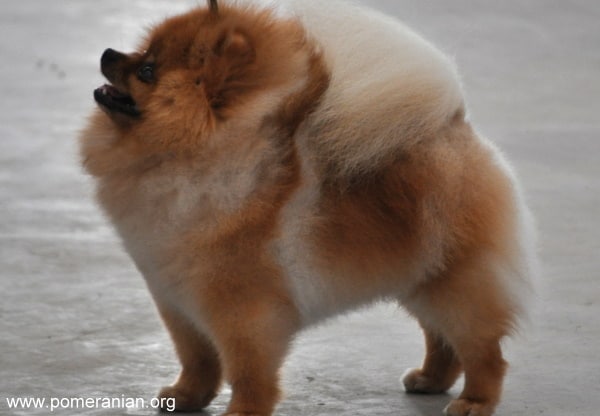
Male Pomeranians may have the abnormal descent of their male parts (one or both). If this is the case, castration is the usual route taken. Ignoring this issue (which is thought to be inherited) can place the pup at a higher risk of testicular cancer.
Pomeranians are Health Tested for the following:
Eye Examination by an Ophthalmologist.
Cardiac Evaluation Advanced Cardiac Exam—OR Congenital Cardiac Exam—We recommend a follow-up evaluation between 3 and 5 years of age.
Hip Dysplasia (Optional) Note: Pomeranian hip problems rarely include Hip Dysplasia.
Legg-Calve-Perthes
Hypothyroidism
Pomeranian Health Test Results should be recorded on the Canine Health Information Center, the CHIC database.
Why Purchasing From a Preservation Breeder is the Best Choice
Ethical Registered Pomeranian breeders are helping to improve the odds of their puppies being strong and healthy by removing any Pomeranians affected with genetic health problems from breeding stock. Knowledge is the answer.
Breeders of registered purebreds are breeding their breed for the betterment of the breed and the long-term love of that breed. Breeders of crossbreeds are only breeding for short-term monetary gains.
Breeders of cross-bred puppies are only “breeding in the dark”; they have no idea what is behind their breeding stock or what genetic problems are hidden. They hope that by crossing two unrelated breeds, problems that affect both breeds will not be present in the resulting litter. Breeders of purebred dogs are very aware of any health problems in their chosen breed.
Testing for genetic problems is now available, & Breed Clubs support these endeavors with dedicated breeders.
Final Thoughts on Common Pomeranian Health Issues
If you’re a Pomeranian owner, it pays to be aware of these health issues. This way, you can ensure your dog has the best care possible to stay healthy and happy! Of course, the first step is knowing what could go wrong with your dog.
N.B. This article regarding Pomeranian health issues was written in consultation with our resident veterinarian.
Dr. Muqeet Mushtaq
DVM, University of Animal and Veterinary Sciences, 2019
MSc. (Hons.) (Animal Breeding & Genetics), University of Agriculture Faisalabad, 2021
Disclaimer: The Content is not a substitute for professional veterinarian advice, diagnosis, or treatment. Always seek the advice of your veterinarian with any questions you may have regarding your dog’s medical condition. Never disregard professional advice or delay seeking it because of something you have read on ANY website.
Copyright Pomeranian.Org. All Rights Reserved.
References and Further Reading:
[1] Denise Leo “The Pomeranian Handbook”.
